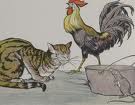The Present Perfect Continuous Tense
Form: have/has + been + present participle. Has is used with third person singular number subject i.e. he, she or it.
We use this tense for an action that began in the past, continues in the present and may continue in the future.
Study these examples:
I have been working in this college for the past ten years. (I am still working here).
I have been trying to solve this problem for an hour. (I am still trying to solve it)
We sometimes use the present perfect continuous even when the action is over. Then we want to emphasize that the activity continued without intermission. Or we are giving a reason or excuse for something.
Study these examples:
He has been reading since morning and now he has a headache.
I have been working in the garden the whole morning. Now I am tired and dirty and need a bath.
Adverbs commonly used in this tense form are: since, for, ever, never, always, often etc. remember since is used with a point of time and for with a period of time.
Verbs like lie (down), rest, sleep, sit are used more often in the present perfect continuous than in the present perfect, e.g.
The football has been lying under the bed the whole day (rather than has lain).
The cat has been sitting under my chair all this time (rather than has sat).
The Past Perfect Continuous Tense
Form: had + been + present participle.
The past perfect continuous tense is used for an action which began at some time in the past and was in progress at some time later in the past. This tense indicates that the earlier of the two actions in the past was continuous.
Study these examples:
She had been writing a novel for the past one year when I visited her last year.
Mr. Fernandez had been teaching in this college for 15 years when I joined in 1995.
The past perfect continuous in indirect speech:
The old woman said, “I have been waiting for my son for seven years.”
The old woman said that she had been waiting for her son for seven years.
The Future Perfect Continuous Tense
Form: shall/will + have + been + present participle.
It denotes an activity partly completed but still in progress over a period of time in future, e.g.
I shall have been working here for 30 years next month.
She will have been talking on the phone for two hours by the time her father arrives.




